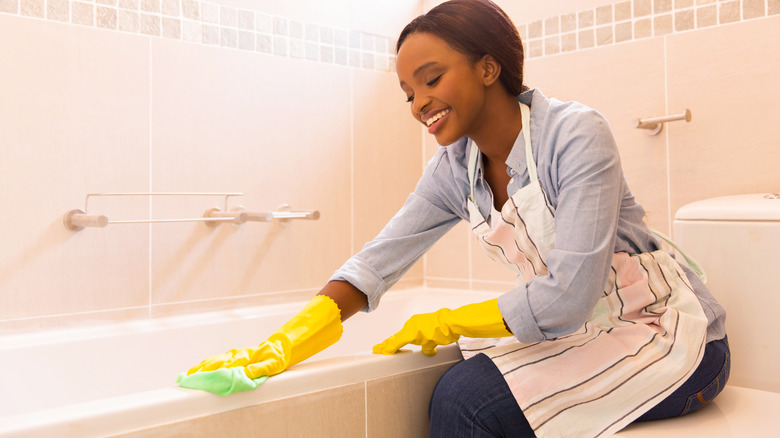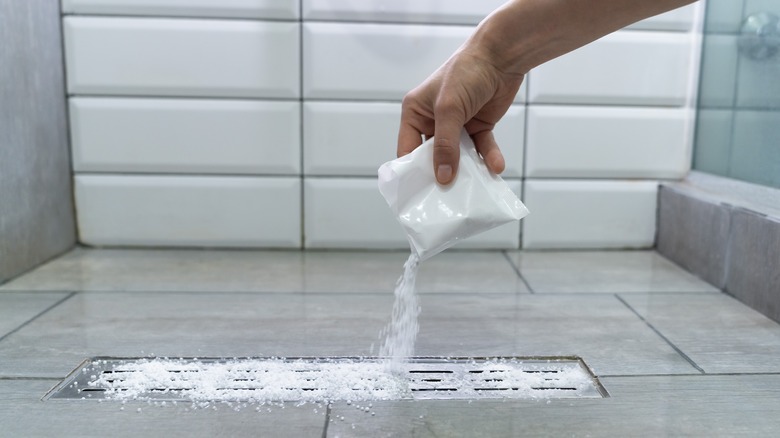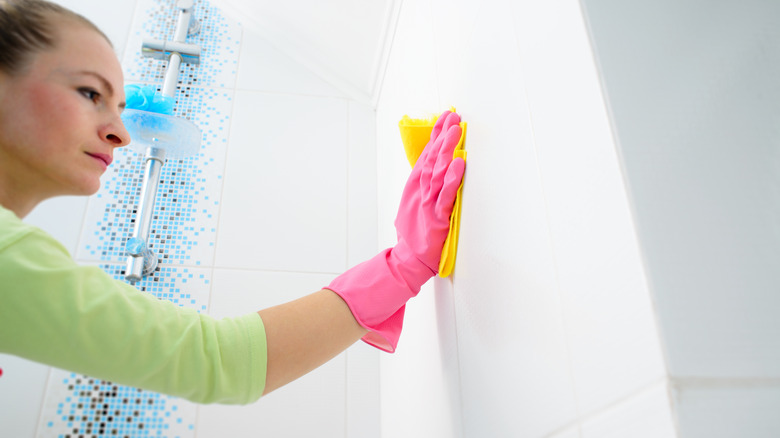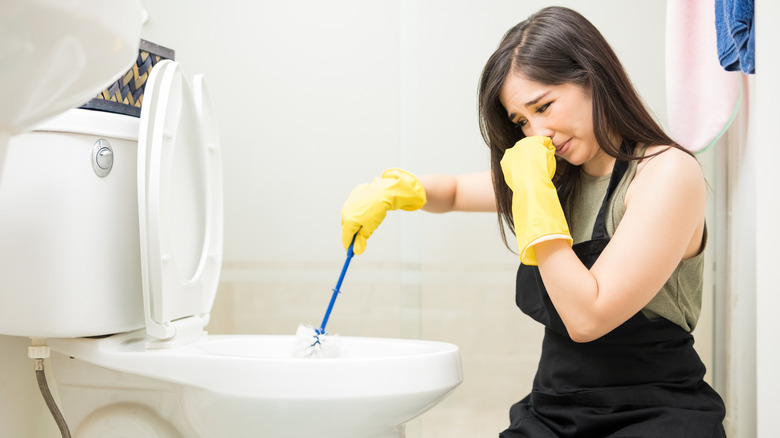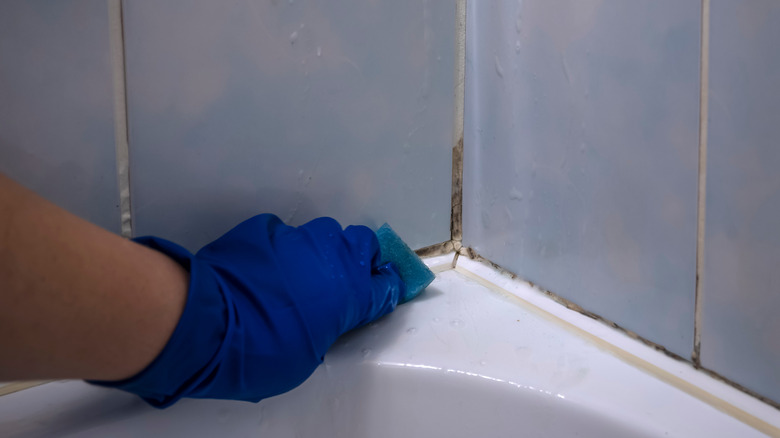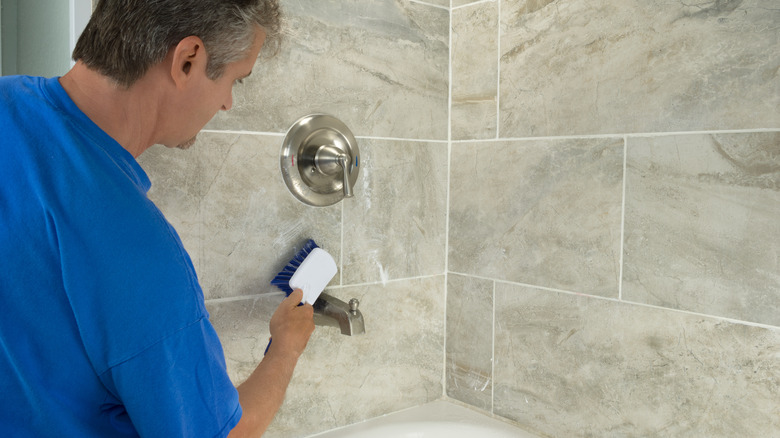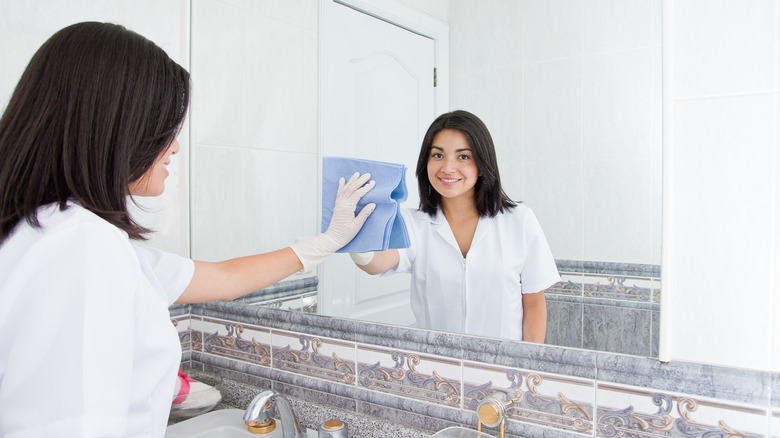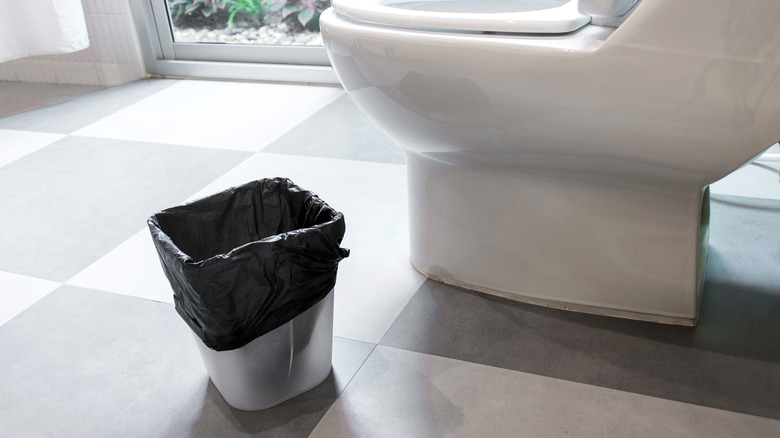9 Clever Ways To Use Epsom Salt To Refresh Your Bathroom
When you go to clean and refresh your home, the bathroom is one area that typically needs special attention, and it's common to use a host of cleaning agents and fresheners to keep it in top shape. However, in the middle of the flood of cleaning hacks, a simple Google search will have Epsom salt popping-up again and again with a host of cleaning uses. There are several clever, but overlooked, ways to add Epsom salt to your bathroom cleaning routine for a greener, more eco-friendly process.
Along with being a popular foot soak and gardening aid, Epsom salt can help you successfully take on some of the biggest bathroom cleaning challenges, like foggy mirrors or dingy tiles and musty towels. However, it's essential to understand why Epsom salt works for these cleaning projects so you can use it with confidence. If you use it correctly, Epsom salt will boost your cleaning game and help you transform your bathroom into a clean, hygienic space without using chemical-heavy products. It also proves that, sometimes, the most effective cleaning allies are unexpected items you already have stashed in your home.
Use Epsom salt to freshen bathroom drains
To refresh your bathroom drains and help clear the gunk, measure a cup of Epsom salt and pour it directly into the drain. Boil a few cups of water and pour the boiling water down the drain after the salt. If you haven't cleaned your drain in a while or you're having trouble with clogging, it's a good idea to repeat this process two or three times in a row to help remove a lot of buildup or stubborn clogs. If your toilet has a clog, Rice University recommends adding 1/4 cup Epsom salt in the toilet bowl, along with some hot water to dissolve it, and letting it sit for 20 minutes before flushing. However, don't add more than 4 cups of Epsom salt in a cleaning session to avoid bigger problems. This method may not be enough for severe clogs, and if you have older piping in your home, use it sparingly because the Epsom salt can stress the pipes.
Using Epsom salt in your drain, followed by boiling water, is effective because of the salt's chemical properties. Epsom salt features sulfate and magnesium, and these are known for having a reaction with various residues that commonly form in drains and pipes, like grime and soap scum. The reaction helps break the substances down and dissolve them, and the boiling water flushes them away to clean and deodorize the pipes. It's an eco-friendly and non-toxic way to clean.
Use an Epsom salt scrub as a tile, grout, and shower door cleaner
Create a gentle but effective scrubbing paste by mixing liquid dish soap with Epsom salt in a bowl. With a scrub brush or sponge, put the paste directly onto whatever you want to clean, like your grout lines, tiles, or shower doors. Gently scrub the surfaces using a circular motion, and leave the paste to sit for 10 to 15 minutes. Rinse the areas thoroughly to get rid of any leftover paste, and test it out on a hidden area first before you cover the whole wall or door to ensure it doesn't cause damage to the grout or scratch the tile or glass.
This Epsom salt scrub works on grout, tile, and glass shower doors in your bathroom because of the combined powers of liquid dish soap with the abrasive nature of the salt. The gritty texture you end up with makes it an excellent abrasive that is powerful enough to scrub away grime, dirt, and soap scum around your bathroom. Also, it's gentle and fine enough that it shouldn't scratch the finish while getting a deep clean. The sulfate content in the salt helps gently dislodge debris so you can rinse them away. When mixed with liquid dish soap, known for its grease-fighting properties, the paste lifts and removes buildup, leaving your bathroom surfaces clean.
Clean your toilet bowl with Epsom salt and baking soda
To create a natural cleaner for your toilet bowl, measure out a cup of baking soda and a cup of Epsom salt. Pour both into the toilet bowl and on the insides of the bowl the best you can. Leave it alone for a few hours to give the baking soda and salt time to go to work on any stains or buildup. You may want to allow it to stay overnight for stubborn stains. You'll then scrub it away with a toilet brush. The mixture and the scrubbing action helps to loosen and strip away any grime to leave a clean toilet behind. To finish, flush the toilet to rinse everything. However, it's important to note that this is a refresh, and it doesn't work well to kill bacteria and germs. If you want to sanitize your toilet bowl, adding disinfectant at the end of your cleaning session is smart.
Combining baking soda and Epsom salt works due to each ingredient's natural properties, and how they interact with common stains you find in your toilet, especially hard water stains. The granular texture with Epsom salt helps break down the stains and buildup, making them easier to remove. Baking soda lends deodorizing and cleaning properties to freshen up your toilet bowl. When they sit in the bowl, they'll get into the stains and start dissolving them, making it easier for you to scrub them away.
Remove mildew on the tub or tile with vinegar and Epsom salt
An easy way to take on mildew growing on your tile or tub is to make a mixture of Epsom salt, white vinegar, and liquid dish soap. Mix a cup of Epsom salt with a cup of vinegar and add a small squirt of dish soap. You should get a thick paste that sticks to vertical surfaces and is abrasive enough to scrub with it. Take the paste and put it right onto any areas with mildew, ensuring you completely cover it and leave it to sit for 10 to 15 minutes to loosen up the mildew. Get a brush or a sponge and scrub the areas until clean. Although it's safe, vinegar can have a strong smell when you use it in small spaces, so make sure you have good ventilation as you work.
Combining liquid dish soap, Epsom salt, and white vinegar works well to strip mildew from your bathtub and tile because each ingredient has unique properties. Epsom salt is abrasive, and this helps you physically scrub at the mildew. White vinegar has a higher acid content that breaks down mildew's structure to make removing it easier. Merry Maids also points out that vinegar's acidity can kill mildew spores and stop them from returning. Finally, liquid dish soap cuts through grime and helps the mixture stick to whatever you're cleaning.
Mix Epsom salt with lemon juice to clean faucets
To polish all your metal fixtures and faucets by removing hard water buildup, Epsom salt, and lemon juice are great options. You'll want to make a paste of equal amounts of Epsom salt and lemon juice. Get a sponge or a soft cloth and add the paste right to your bathroom fixtures and faucets, making sure you cover everything, especially visible water spots, soap scum, or other buildup. Apply light pressure and gently scrub to lift and remove any grime. Once you finish scrubbing, let it sit again for a few minutes to dissolve any leftover deposits or blemishes before rinsing and drying your faucets or fixtures. Additionally, ensure you rinse well because allowing the lemon juice to sit on the faucets can potentially damage the finish.
Combining lemon juice with Epsom salt gives you an eco-friendly but effective method to clean your bathroom. Epsom salt is lightly abrasive, and this helps you scrub away mineral deposits and hard water spots that commonly appear on your faucets and fixtures. Lemon juice contains a high amount of citric acid, and this will dissolve grime and cut through soap scum as it comes into contact with it. It'll break down the deposits and make it much easier for you to scrub them away with Epsom salt.
Use Epsom salt to refresh shower curtains
When you decide to refresh and clean your shower curtain, Epsom salt is a natural solution that helps get rid of mildew. Get a gallon of warm water and fully dissolve Epsom salts in it. If you can easily remove your shower curtain, take it down and put it into a large basin or bathtub full of this solution, letting it soak for at least an hour. As it soaks, it'll loosen up any soap scum, grime, or early mildew spots. If you can't take it down, soak a cloth or sponge in the water and salt mixture and wipe down your shower curtain. When you finish, rinse it thoroughly and allow it to dry. This method works well for light stains or buildup, so if you have a mildew issue, you may need a more robust cleaning agent, like white vinegar, to tackle them.
The unique properties of Epsom salt make it an effective shower curtain cleaner. Epsom salt is a mineral with a higher amount of sulfate and magnesium, and it absorbs moisture. Putting it on your shower curtain helps reduce how much moisture sits on the curtain's surface. This is critical because warm, damp environments are breeding grounds for mold and mildew, and lowering the moisture content makes it harder for these things to grow.
Use dissolved Epsom salt to clean your mirrors
Dissolve a tablespoon of Epsom salt into half a gallon of water to get streak-free mirrors. Take a few minutes to stir the solution until the salt dissolves, ensuring nothing is left to scratch the mirror. Dip a soft sponge or cloth into the mixture and wring it out so it's damp and not soaking. Gently wipe your bathroom mirrors down, covering the entire surface. If you see stubborn spots, you may need to take a second pass or press harder as you clean. When you finish, get a second dry cloth and buff the mirror to dry it and get a streak-free shine. Also, ensure you use a cloth that won't leave behind fibers or lint.
The salt's inherent properties make it an excellent natural cleaner for your bathroom mirrors. When you dissolve Epsom salt in water, you get a solution that cuts through the residues you commonly find on bathroom mirrors, like fingerprints, water spots, and toothpaste splatters. The salt is a mild abrasive on a microscopic level, and it lifts the grime without scratching the glass. This is especially helpful for keeping the appearance and function of bathroom mirrors, which always get these kinds of splatters and spots. The solution also leaves a streak-free finish because the salt encourages the water to evaporate evenly.
Create an Epsom salt soak to freshen bathroom towels
To freshen your bathroom towels and linens, mix hot water and Epsom salt. Fill the bathtub with hot water, enough to submerge the towels. Add half a cup of Epsom salt for every gallon of water you put into the bath, and stir until it completely dissolves. Submerge your towels into the solution and leave them to soak for at least an hour so the saltwater can get into the fibers. This presoak will loosen up any detergent buildup or mineral deposits that could be impacting how soft your towels are and how well they absorb water. At the end of the hour, wring each towel to get as much excess water out as possible and then wash the towels as you usually would. Once you wash, put them in a rinse cycle without any fabric softener to remove the salt residue.
Epsom salt makes for a great pre-soak solution due to the magnesium and sulfate that can break down and dissolve any detergent buildup and mineral deposits stuck in the fibers. By stripping them out, you'll revive the softness in your towels and the absorbency levels that make them seem new. When you combine the Epsom salt with hot water, the salt's solubility increases.
Use Epsom salt and baking soda to deodorize and clean waste bins
To deodorize and clean your bathroom waste bins, start with an empty and dry bin. Sprinkle a layer of Epsom salt into the bottom and leave it. This salt layer will absorb any moisture that may build up from spills or condensation, making the environment unfavorable for mold or bacteria growth. To make it more effective, sprinkle a layer of baking soda over the salt and put a new liner into your waste bin. Refresh the salts and baking soda every other week or so to ensure it keeps working. Also, note that baking soda and Epsom salts help control odor and moisture but don't disinfect. Regularly washing and disinfecting your waste bins is critical to eliminate any lingering bacteria or mold.
Epsom salt's ability to absorb moisture plays a critical role in why it's able to help control odor in your waste bins. Moist environments are the perfect places for mold and bacteria to thrive, bringing unpleasant smells. By removing this moisture, Epsom salt helps keep the interior dry and less hospitable for microorganisms. Also, when you combine it with baking soda, you get a better ability to absorb and neutralize odors, giving you a fresher-smelling bathroom.
